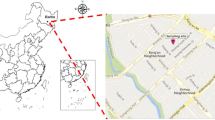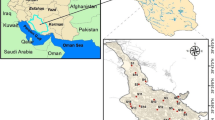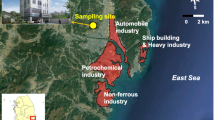Abstract
The present study proposed to investigate the atmospheric distribution, sources, and inhalation health risks of polycyclic aromatic hydrocarbons (PAHs) in a tropical megacity (Delhi, India). To this end, 16 US EPA priority PAHs were measured in the inhalable fraction of atmospheric particles (PM10; aerodynamic diameter, ≤10 μm) collected weekly at three residential areas in Delhi from December 2008 to November 2009. Mean annual 24 h PM10 levels at the sites (166.5–192.3 μg m−3) were eight to ten times the WHO limit. Weekday/weekend effects on PM10 and associated PAHs were investigated. Σ16PAH concentrations (sum of 16 PAHs analyzed; overall annual mean, 105.3 ng m−3; overall range, 10.5–511.9 ng m−3) observed were at least an order of magnitude greater than values reported from European and US cities. Spatial variations in PAHs were influenced by nearness to traffic and thermal power plants while seasonal variation trends showed highest concentrations in winter. Associations between Σ16PAHs and various meteorological parameters were investigated. The overall PAH profile was dominated by combustion-derived large-ring species (85–87 %) that were essentially local in origin. Carcinogenic PAHs contributed 58–62 % to Σ16PAH loads at the sites. Molecular diagnostic ratios were used for preliminary assessment of PAH sources. Principal component analysis coupled with multiple linear regression-identified vehicular emissions as the predominant source (62–83 %), followed by coal combustion (18–19 %), residential fuel use (19 %), and industrial emissions (16 %). Spatio-temporal variations and time-evolution of source contributions were studied. Inhalation cancer risk assessment showed that a maximum of 39,780 excess cancer cases might occur due to lifetime inhalation exposure to the analyzed PAH concentrations.



Similar content being viewed by others
References
Akyüz, M., & Çabuk, H. (2009). Meteorological variations of PM2.5/PM10 concentrations and particle-associated polycyclic aromatic hydrocarbons in the atmospheric environment of Zonguldak, Turkey. Journal of Hazardous Materials, 170, 13–21.
Behymer, T. D., & Hites, R. A. (1988). Photolysis of polycyclic aromatic hydrocarbons adsorbed on fly ash. Environmental Science and Technology, 22, 1311–1319.
Bosetti, C., Boffetta, P., & La Vecchia, C. (2007). Occupational exposures to polycyclic aromatic hydrocarbons, and respiratory and urinary tract cancers: a quantitative review to 2005. Annals of Oncology, 18, 431–446.
Brag, A. L. F., Zanobetti, A., & Schwartz, J. (2001). The lag structure between particulate air pollution and respiratory and cardiovascular deaths in ten U.S. cities. Journal of Occupational and Environmental Medicine, 43, 927–933.
Budzinsky, H., Jones, I., Bellocq, J., Pierard, C., & Garrigues, P. (1997). Evaluation of sediment contamination by polycyclic aromatic hydrocarbons in the Gironde estuary. Marine Chemistry, 58, 85–97.
Burkart, K., Nehls, I., Win, T., & Endlicher, W. (2011). The carcinogenic risk and variability of particulate-bound polycyclic aromatic hydrocarbons with consideration of meteorological conditions. Air Quality, Atmosphere and Health. doi:10.1007/s11869-011-0135-6.
Callén, M. S., López, J. M., & Mastral, A. M. (2011). Characterization of PM10-bound polycyclic aromatic hydrocarbons in the ambient air of Spanish urban and rural areas. Journal of Environmental Monitoring, 13, 319–327.
Caricchia, A. M., Chiavarini, S., & Pezza, M. (1999). Polycyclic aromatic hydrocarbons in the urban atmospheric particulate matter in the city of Naples (Italy). Atmospheric Environment, 33, 3731–3738.
Census 2011. Census of India. Office of the Registrar General and Census Commissioner, Government of India.
CEPA. (2004). The report on diesel exhaust. California Environmental Protection Agency. Available online at http://www.arb.ca.gov/toxics/dieseltac/de-fnds.htm
Chauhan, C. (2007). SC seeks Centre’s reply on diesel pollution report. New Delhi: The Hindustan Times.
Dickhut, R. M., Canuel, E. A., Gustafson, K. E., Liu, K., Arzayus, K. M., Walker, S. E., et al. (2000). Automotive sources of carcinogenic polycyclic aromatic hydrocarbons associated with particulate matter in Chesapeake Bay region. Environmental Science and Technology, 34, 4635–4640.
Duval, M., & Friedlander, S. (1981). Source resolution of polycyclic aromatic hydrocarbons in the Los Angles atmospheres: application of a CMB with first order decay. Washington, DC: United States Environmental Protection Agency.
EC. (2004). Directive 2004/107/EC of the European Parliament and of the Council of 15 December 2004 relating to arsenic, cadmium, mercury, nickel and PAH in ambient air. European Council.
Esen, F., Tasdemir, Y., & Vardar, N. (2008). Atmospheric concentrations of PAHs, their possible sources and gas-to-particle partitioning at a residential site of Bursa, Turkey. Atmospheric Research, 88, 243–255.
Fang, G. C., Chang, C. N., Wu, Y. S., Fu, P. P. C., Yang, I. L., & Chen, M. H. (2004). Characterization, identification of ambient air and road dust polycyclic aromatic hydrocarbons in central Taiwan, Taichung. Science of the Total Environment, 327, 135–146.
Finlayson-Pitts, B. J., & Pitts, J. N., Jr. (2000). Chemistry of upper and lower atmosphere: theory, experiments and applications. San Diego: Academic.
Gaspari, L., Chang, S. S., Santella, R. M., Garte, S., Pedotti, P., & Taioli, E. (2003). Polycyclic aromatic hydrocarbon-DNA adducts in human sperm as marker of DNA damage and infertility. Mutation Research, 535, 155–160.
Guo, H., Lee, S. C., Ho, K. F., Wang, X. M., & Zou, S. C. (2003). Particle-associated polycyclic aromatic hydrocarbons in urban air of Hong Kong. Atmospheric Environment, 37, 5307–5317.
Gurjar, B. R., Jain, A., Sharma, A., Agarwal, A., Gupta, P., Nagpure, A. S., et al. (2010). Human health risks in megacities due to air pollution. Atmospheric Environment, 44, 4606–4613.
Hanedar, A., Alp, K., Kaynak, B., Baek, J., Avsar, E., & Odman, M. T. (2011). Concentrations and sources of PAHs at three stations in Istanbul, Turkey. Atmospheric Research, 99, 391–399.
Jia, Y., Stone, D., Wang, W., Schrlau, J., Tao, S., & Simonich, S. L. M. (2011). Estimated reduction in cancer risk due to PAH exposures if source control measures during the 2008 Beijing Olympics were sustained. Environmental Health Perspectives, 119, 815–820.
Kadian, R., Dahiya, R. P., & Garg, H. P. (2007). Energy-related emissions and mitigation opportunities from the household sector in Delhi. Energy Policy, 35, 6195–6211.
Karar, K., & Gupta, A. K. (2006). Seasonal variation and chemical characterization of ambient PM10 at residential and industrial sites of an urban region of Kolkata (Calcutta), India. Atmospheric Research, 81, 36–53.
Khalili, N. R., Scheff, P. A., & Holsen, T. M. (1995). PAH source fingerprints for coke ovens, diesel and gasoline engine highway tunnels and wood combustion emissions. Atmospheric Environment, 29, 533–542.
Khillare, P. S., Agarwarl, T., & Shridhar, V. (2008). Impact of CNG implementation on PAHs concentration in the ambient air of Delhi: a comparative assessment of pre- and post-CNG scenario. Environmental Monitoring and Assessment, 147, 223–233.
Kong, S., Shi, J., Lu, B., Qiu, W., Zhang, B., Peng, Y., et al. (2011). Characterization of PAHs within PM10 fraction for ashes from coke production, iron smelt, heating station and power plant stacks in Liaoning Province, China. Atmospheric Environment, 45, 3777–3785.
Kulkarni, P., & Venkataraman, C. (2000). Atmospheric polycyclic aromatic hydrocarbons in Mumbai, India. Atmospheric Environment, 34, 2785–2790.
Kulshrestha, A., Satsangi, P. G., Masih, J., & Taneja, A. (2009). Metal concentration of PM2.5 and PM10 particles and seasonal variations in urban and rural environment of Agra, India. Science of the Total Environment, 407, 6196–6204.
Larsen, R. K., & Baker, J. E. (2003). Source apportionment of polycyclic aromatic hydrocarbons in the urban atmosphere: a comparison of three methods. Environmental Science and Technology, 37, 1873–1881.
Li, Z., Porter, E. N., Sjödin, A., Needham, L. L., Lee, S., Russell, A. G., et al. (2009). Characterization of PM2.5-bound polycyclic aromatic hydrocarbons in Atlanta – Seasonal variations at urban, suburban, and rural ambient air monitoring sites. Atmospheric Environment, 43, 4187–4193.
Liao, C.-M., & Chiang, K.-C. (2006). Probabilistic risk assessment for personal exposure to carcinogenic polycyclic aromatic hydrocarbons in Taiwanese temples. Chemosphere, 63, 1610–1619.
Lisouza, F. A., Owuor, O. P., & Lalah, J. O. (2011). Variation in indoor levels of polycyclic aromatic hydrocarbons from burning various biomass types in the traditional grass-roofed households in Western Kenya. Environmental Pollution, 159, 1810–1815.
Manoli, E., Kouras, A., & Samara, C. (2004). Profile analysis of ambient and source emitted particle-bound polycyclic aromatic hydrocarbons from three sites in northern Greece. Chemosphere, 56, 867–878.
MoEF. (2009). Environment (Protection) Seventh Amendment Rules. New Delhi: Ministry of Environment and Forests, Government of India Press.
Nisbet, C., & LaGoy, P. (1992). Toxic equivalency factors (TEFs) for polycyclic aromatic hydrocarbons (PAHs). Regulatory Toxicology and Pharmacology, 16, 290–300.
Pandey, J. S., Kumar, R., & Devotta, S. (2005). Health risks of NO2, SPM and SO2 in Delhi (India). Atmospheric Environment, 39, 6868–6874.
Panther, B. C., Hooper, M. A., & Tapper, N. J. (1999). A comparison of air particulate matter and associated polycyclic aromatic hydrocarbons in some tropical and temperate urban environments. Atmospheric Environment, 33, 4087–4099.
Park, S. S., Kim, Y. J., & Kang, C. H. (2002). Atmospheric polycyclic aromatic hydrocarbons in Seoul, Korea. Atmospheric Environment, 36, 2917–2924.
Planning Department. (2009). Economic survey of Delhi 2008–2009. Government of NCT of Delhi.
Rinehart, L. R., Fujitaa, E. M., Chowa, J. C., Maglianob, K., & Zielinska, B. (2006). Spatial distribution of PM2.5 associated organic compounds in central California. Atmospheric Environment, 40, 290–303.
Saarnio, K., Sillanpää, M., Hillamo, R., Sandell, E., Pennanen, A. S., & Salonen, R. O. (2008). Polycyclic aromatic hydrocarbons in size-segregated particulate matter from six urban sites in Europe. Atmospheric Environment, 42, 9087–9097.
Samet, J. M., Domonici, F., Frank, C., Curriero, C. I., & Zeger, S. L. (2000). Fine particulate air pollution and mortality in 20 U.S. cities, 1987–1994. The New England Journal of Medicine, 343, 1742–1749.
Sarkar, S., Khillare, P. S., Jyethi, D. S., Hasan, A., & Parween, M. (2010). Chemical speciation of respirable suspended particulate matter during a major firework festival in India. Journal of Hazardous Materials, 184, 321–330.
Seinfeld, J. H., & Pandis, S. N. (2006). Atmospheric chemistry and physics: from air pollution to climate change. New York: Wiley.
Sharma, H., Jain, V. K., & Khan, Z. H. (2007). Characterization and source identification of polycyclic aromatic hydrocarbons (PAHs) in the urban environment of Delhi. Chemosphere, 66, 302–310.
Sharma, H., Jain, V. K., & Khan, Z. H. (2008). Atmospheric polycyclic aromatic hydrocarbons (PAHs) in the urban air of Delhi during 2003. Environmental Monitoring and Assessment, 147, 43–55.
Simcik, M. F., Eisenreich, S. J., & Lioy, P. J. (1999). Source apportionment and source/sink relationship of PAHs in the coastal atmosphere of Chicago and Lake Michigan. Atmospheric Environment, 33, 5071–5079.
Šišović, A., Bešlić, I., Šega, K., & Vadjić, V. (2008). PAH mass concentrations measured in PM10 particle fraction. Environment International, 34, 580–584.
Tham, Y. W. F., Takeda, K., & Sakugawa, H. (2008). Polycyclic aromatic hydrocarbons (PAHs) associated with atmospheric particles in Higashi Hiroshima, Japan: influence of meteorological conditions and seasonal variations. Atmospheric Research, 88, 224–233.
US EPA. (2002). Polycyclic Organic Matter. United States Environmental Protection Agency. Available online at http://www.epa.gov/ttn/atw/hlthef/polycycl.html
Vasconcellos, P. C., Zacarias, D., Pires, M. A. F., Pool, C. S., & Carvalho, L. R. F. (2003). Measurements of polycyclic aromatic hydrocarbons in airborne particles from the metropolitan area of São Paulo City, Brazil. Atmospheric Environment, 37, 3009–3018.
Wada, M., Kido, H., Kishikawa, N., Tou, T., Tanaka, M., Tsubokura, J., et al. (2001). Assessment of air pollution in Nagasaki city: determination of polycyclic aromatic hydrocarbons and their nitrated derivatives, and some metals. Environmental Pollution, 115, 139–147.
Wang, X., Cheng, H., Xu, X., Zhuang, G., & Zhao, C. (2008). A wintertime study of polycyclic aromatic hydrocarbons in PM2.5 and PM2.5–10 in Beijing: assessment of energy structure conversion. Journal of Hazardous Materials, 157, 47–56.
WHO. (2006). WHO air quality guidelines for particulate matter, ozone, nitrogen dioxide and sulfur dioxide: Global update 2005. World Health Organization.
Yassaa, N., Meklati, B. Y., Cecinato, A., & Marino, F. (2001). Particulate n-alkanes, n-alkanoic acids and polycyclic aromatic hydrocarbons in the atmosphere of Algiers City Area. Atmospheric Environment, 35, 1843–1851.
Yu, Y., Guo, H., Liu, Y., Huang, K., Wang, Z., & Zhan, X. (2008). Mixed uncertainty analysis of polycyclic aromatic hydrocarbon inhalation and risk assessment in ambient air of Beijing. Journal of Environmental Sciences, 20, 505–512.
Yunker, M. B., MacDonald, R. W., Vingarzan, R., Mitchell, R. H., Goyette, D., & Sylvestre, S. (2002). PAHs in the Fraser River basin: a critical appraisal of PAH ratios as indicators of PAH source and composition. Organic Geochemistry, 33, 489–515.
Zhang, Y., & Tao, S. (2009). Global atmospheric emission inventory of polycyclic aromatic hydrocarbons (PAHs) for 2004. Atmospheric Environment, 43, 812–819.
Acknowledgments
One of the authors, Sayantan Sarkar, wishes to thank the Indian Association of Parliamentarians on Population and Development (IAPPD) for providing financial assistance in the form of Sat Paul Mittal Fellowship during the course of this work. This work was financially supported by a project (no. 19/4/2007-RE) sponsored by the Ministry of Environment and Forests (MoEF), Government of India. The authors gratefully acknowledge the anonymous reviewers for their valuable comments and suggestions.
Author information
Authors and Affiliations
Corresponding author
Electronic supplementary material
Below is the link to the electronic supplementary material.
ESM 1
(DOC 66 kb)
Rights and permissions
About this article
Cite this article
Sarkar, S., Khillare, P.S. Profile of PAHs in the inhalable particulate fraction: source apportionment and associated health risks in a tropical megacity. Environ Monit Assess 185, 1199–1213 (2013). https://doi.org/10.1007/s10661-012-2626-9
Received:
Accepted:
Published:
Issue Date:
DOI: https://doi.org/10.1007/s10661-012-2626-9




